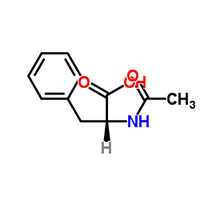Synonyms
D-Phenylalanine, N-acetyl-
N-Acetyl-3-phenyl-L-alanine
(2R)-2-acetamido-3-phenylpropanoic acid
N-Acetyl-D-phenylalanine
N-Acetyl-l-Phenylalanine
Acetyl-L-phenylalanine
(S)-2-Acetamido-3-phenylpropanoic acid
EINECS 217-959-8
N-acetyl-D,L-phenylalanine
(2S)-2-acetamido-3-phenylpropanoic acid
L-N-Acetylphenylalanine
MFCD00063158
Ac-Phe-OH
Acetyl-D-Phenylalanine
acetylphenylalanine
Ac-D-Phe-OH
Product Description
Introduction:
N-Acetyl-L-phenylalanine, commonly known as N-Acetylphenylalanine or NAPA, is an essential chemical
compound with significant applications in the chemical industry. This product introduction aims to
provide an overview of N-Acetyl-L-phenylalanine, covering its raw materials, production process, market
trends, and the current status of amino acids in the industry.
Raw Materials:
N-Acetyl-L-phenylalanine is synthesized through a combination of raw materials, primarily
L-phenylalanine and acetic acid. L-phenylalanine, an essential amino acid, serves as the precursor for
NAPA synthesis. Acetic acid, commonly derived from petrochemical sources or fermentation processes,
provides the acetyl group necessary for the acetylation of L-phenylalanine.
Production Process:
The production process of N-Acetyl-L-phenylalanine involves the following steps:
Step 1: Extraction of L-phenylalanine - L-phenylalanine is typically obtained from natural sources, such
as protein-rich food products or fermentation of microbial cultures.
Step 2: Acetylation reaction - L-phenylalanine is reacted with acetic acid in the presence of suitable
catalysts and reaction conditions to form N-Acetyl-L-phenylalanine. The reaction may take place in a
solvent or in the solid state, depending on the specific manufacturing process.
Step 3: Purification and refining - The resulting N-Acetyl-L-phenylalanine is purified using various
techniques, such as filtration, crystallization, and chromatography, to achieve the desired level of
purity.
Market Trends:
The market demand for N-Acetyl-L-phenylalanine has been steadily increasing due to its versatile
applications across various industries. Here are some key market trends:
Pharmaceutical Industry: N-Acetyl-L-phenylalanine finds extensive use as a building block for the
synthesis of novel pharmaceutical compounds. Its role as a precursor in drug discovery and development
processes makes it a valuable ingredient in the pharmaceutical sector.
Nutraceuticals and Dietary Supplements: The growing awareness regarding health and wellness has fueled
the demand for amino acid-based nutraceuticals and dietary supplements. N-Acetyl-L-phenylalanine's
inclusion in these products is driven by its potential to support cognitive function and mood
enhancement.
Cosmetics and Personal Care: N-Acetyl-L-phenylalanine's skin-whitening properties have gained attention
in the cosmetics industry. It is utilized as an ingredient in skin care products, particularly those
aimed at reducing pigmentation and promoting even skin tone.
Current Status of Amino Acids:
Amino acids play a crucial role in various sectors, including pharmaceuticals, food additives, animal
nutrition, and agriculture. The demand for amino acids continues to grow due to their diverse
applications. In particular, the market for essential amino acids, including phenylalanine, remains
robust due to their importance in protein synthesis and their therapeutic potential.
Conclusion:
N-Acetyl-L-phenylalanine, a derivative of L-phenylalanine, holds significant value in the chemical
industry. Its synthesis involves the combination of raw materials and precise production processes. The
market demand for N-Acetyl-L-phenylalanine is driven by its applications in pharmaceuticals,
nutraceuticals, cosmetics, and personal care. As amino acids continue to play a vital role across
multiple industries, N-Acetyl-L-phenylalanine maintains its position as a valuable chemical compound in
the market.





